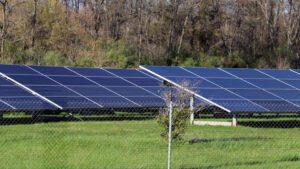Nearly two-thirds of England’s largest solar farms have been built on productive agricultural land, with a third of their area sited on the nation’s most valuable farmland, according to a damning new report from countryside charity CPRE.
The charity’s analysis of 38 mega-scale solar farms – each generating more than 30MW – reveals that 59% are located on farmland, despite planning rules meant to protect such areas. Alarmingly, 827 hectares of Grade 1-3a land, classified as ‘best and most versatile’ (BMV), have been taken out of food production, equivalent to about 1,300 football pitches.
Three of the developments — at Sutton Bridge in Lincolnshire, Goosehall in East Cambridgeshire, and Black Peak Farm in South Cambridgeshire — are sited entirely on BMV land.
CPRE is now calling on the government to shift solar development away from green fields and onto rooftops, car parks and brownfield sites, warning that continued loss of prime agricultural land threatens UK food security at a time of increasing global uncertainty.
“This isn’t just about protecting our countryside,” said Jackie Copley, CPRE’s campaigns lead and author of the report. “It’s about smart energy planning that brings people together around practical solutions that work for everyone.”
Despite longstanding planning policy to preserve England’s best farmland, CPRE found that more than half (53%) of these large solar sites include Grade 1-3a land.
An additional 755 hectares of slightly lower quality Grade 3b land has also been developed. The vast majority of affected land lies in eastern England, where high-quality soil and flat terrain make it attractive to solar developers — but also vital to domestic food production.
With government targets to scale solar power from 16.6 GW today to 45-47 GW by 2030, the pressure on farmland is set to intensify. CPRE warns that current policy could see as much as 65% of that expansion coming from ground-mounted solar — removing thousands more hectares of farmland from use for up to 60 years.
The charity argues that this approach undermines national food resilience and risks fuelling rural opposition to the clean energy transition.
“While there’s common cause in achieving clean power, the current approach is short-sighted and wasteful,” said Copley. “We’re needlessly sacrificing irreplaceable farmland when rooftops, car parks and brownfield sites could do the job just as well — if not better.”
CPRE’s previous research shows that solar panels on the roofs of homes, warehouses, supermarkets and car parks could provide 40-50 GW by 2035 — enough to meet current national targets without touching greenfield land. By 2050, that figure could rise to 117 GW.
The charity is urging the government to set a formal target for at least 60% of future solar generation to come from rooftops and brownfield sites, and to ban solar farms on Grades 1 and 2 agricultural land altogether.
It also points to stark geographic imbalances in solar development. In Sleaford and North Hykeham in Lincolnshire, 7% of all land is now covered by solar — nearly 20 times the national average projection of 0.4%.
The release of CPRE’s report comes just weeks after the government published its Solar Roadmap, which includes proposals to boost rooftop deployment. While the charity welcomed that ambition, it says the policy still falls short of what is required to avoid widespread land-use conflict and preserve the countryside.
“The government must do more — and faster — to unlock the vast untapped potential of rooftop solar,” said Copley. “By focusing on existing buildings instead of productive fields, we can decarbonise the grid, safeguard food production, and avoid pitting clean energy against rural communities.”
Read more:
Mega solar farms built on England’s best farmland, CPRE warns

